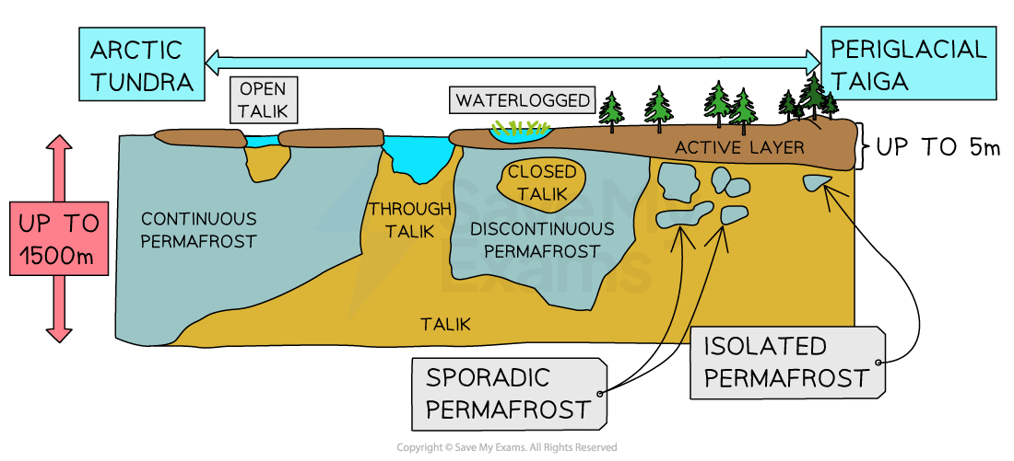Past & Present Periglacial Landscapes
- A periglacial landscape is characterised by permanently frozen ground or permafrost and is defined as:
‘An area where soil and rock has not risen above 0°C for at least 2 consecutive years'
- Approximately 25% of the Earth's surface is considered periglacial, but during the Pleistocene epoch it covered as much as 45% of the surface, extending into the lower latitudes of southern England and Europe
- Permafrost is not controlled by soil moisture and ice does not need to be present
- Permafrost is prevalent in Siberia (up to 1500m deep) and Northern Canada (depths of 700m)
- Most permafrost water stays frozen as ground ice
Comparison of Glacial and Periglacial Areas
| Action |
Periglacial | Glacial |
| Altered by ice | Within the ground | Above ground |
| Landforms created through | Freeze/thaw weathering and mass movement | Erosion and deposition |
| Found | Outer margins of cold environments, especially in the northern hemisphere around the Arctic; high altitudes and continental interiors | High altitudes and latitudes |
-
- Areas of unfrozen ground within the permafrost are known as talik
- Talik can be:
- Open - a small area of unfrozen ground exposed to the surface
- Through - a large mass of unfrozen ground beneath a small open area
- Closed - unfrozen ground surrounded by permafrost
- Permafrost can be subdivided into:
- Continuous - large, unbroken stretches of permafrost, that reach depths of up to 1,500 meters – largest areas are located in Canada, Alaska and Siberia
- Discontinuous - mostly permafrost, with some small, localised unfrozen ground (talik)
- Sporadic - where small patches of frozen ground occur in talik (unfrozen ground)
- Isolated - there are random pockets of permafrost within the talik
- Subsea - or offshore permafrost is frozen ground within seabed sediments. Originally formed on land and was subsequently submerged as sea levels rose after the last Ice Age

Image showing types of permafrost found in periglacial areas
- Seasonal melting at the surface produces the active layer of between 2cm to 5m in depth
- However, any meltwater cannot drain through the impermeable permafrost below and sits on the surface as thaw lakes
- Thaw lakes are common in these poorly drained areas and as the water continues to absorb solar radiation, the depth and size of these lakes increase in size
- In the past, the area of permafrost was more extensive and permafrost covered most of southern England, giving it a tundra landscape
- The periglacial landscape is littered with angular rocks across its surface
- Quickly weathered through freeze-thaw processes, these areas are called felsenmeer, meaning 'field of rocks' in German




